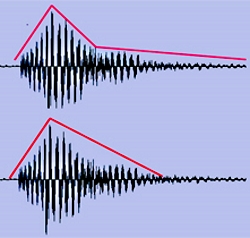When you first started using a compressor, you were happy to just have a basic understanding of what the threshold and ratio do, right? At some point, though, you need to learn how to deal with the attack setting.
I’ll give you a starting point today.
The attack setting simply tells the compressor how quickly it should compress the signal once it crosses the threshold. Note: Don’t confuse attack with ratio. Ratio tells the compressor how much to compress once it crosses the threshold.
Start Slow
When you’re dating a compressor, it’s important to take things slow.
My buddy Ian has been known to say that fast attack times kill music. For the most part, he’s right. Music is all about rhythm and emotion. If your attack times are too short, you’re chopping off the transients on your tracks… losing that punch you’re trying to get.
While I’ll admit it’s fun to use a fast attack and watch the gain reduction meter bounce all over the place, it’s best to try to get into the habit of using slow attack times. The compression will be more subtle, and you’ll be less likely to over-compress the track.
Rather than starting at 5 or 10 ms…dial that puppy back to something like 50-75 ms. Let those transients through! Then let the compression shape the tone of the instrument AFTER the transient.
Missing The “Punch”
People talk all the time about wanting their mixes to “punch.” So they talk about using analog summing, or buying fancy plug-ins.
I’m not against either of those, but before you go there, try increasing your attack times on your compressors. You may just re-discover that punch you were looking for.
When To Go Fast
Of course, there are times to use fast attack times, too. Whenever the transients of a given signal are too loud or need to be “tamed” a bit, you should try using a faster attack time.
The best way to do this is to set your ratio and threshold where you want them, then slowly dial back the attack knob. As the attack time shortens, the underlying audio will slowly become more and more “dull.”
That’s not necessarily a bad thing, and it might be just the thing you’re looking for for a particular track. Here are a few examples of when it makes sense to use a fast attack time:
—Too much “thump” in the bass. Perhaps your bass player digs in really hard when he plays bass, so all his notes have a really loud transient, but it’s hard to hear the sustain.
Or perhaps you can’t get a good overall bass level in your mix without the transients overtaking the mix. Use a faster attack time to clamp down on these transients before they get out of control.
—Snare drum cuts through the mix too much. Sometimes you just can’t get the snare drum to sit in the mix. You turn it up, it cuts through too much. you turn it down, you can’t hear it.
A faster attack will let you turn it up without it chopping your ears off at the beginning of each hit.
—Lead vocals. Sometimes a slow attack on vocals can make it sound a bit odd.
If you’ve ever listened to a talk radio show where every phrase the announcer says has too much “punch” at the beginning? Yeah, that’s probably due to over-compression and a slow attack time.
Joe Gilder is a Nashville based engineer, musician, and producer who also provides training and advice at the Home Studio Corner.















